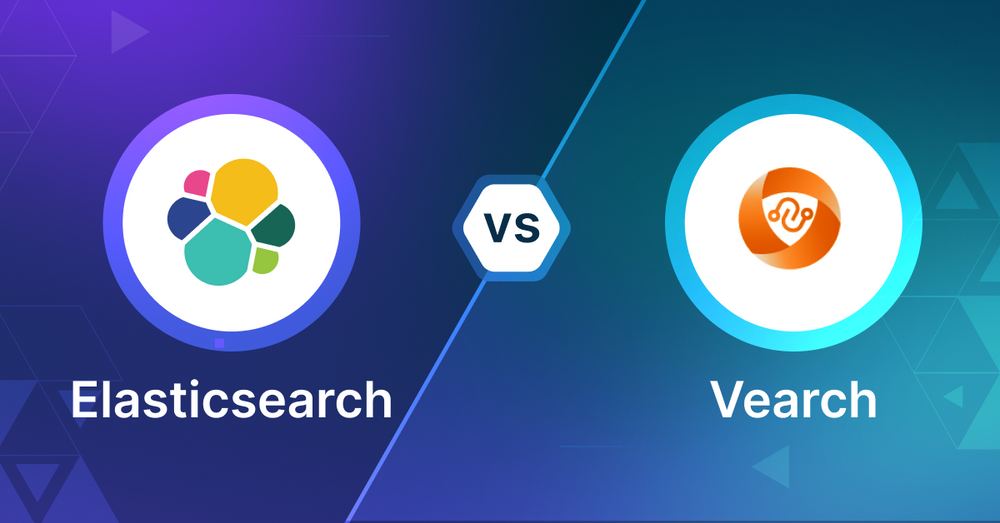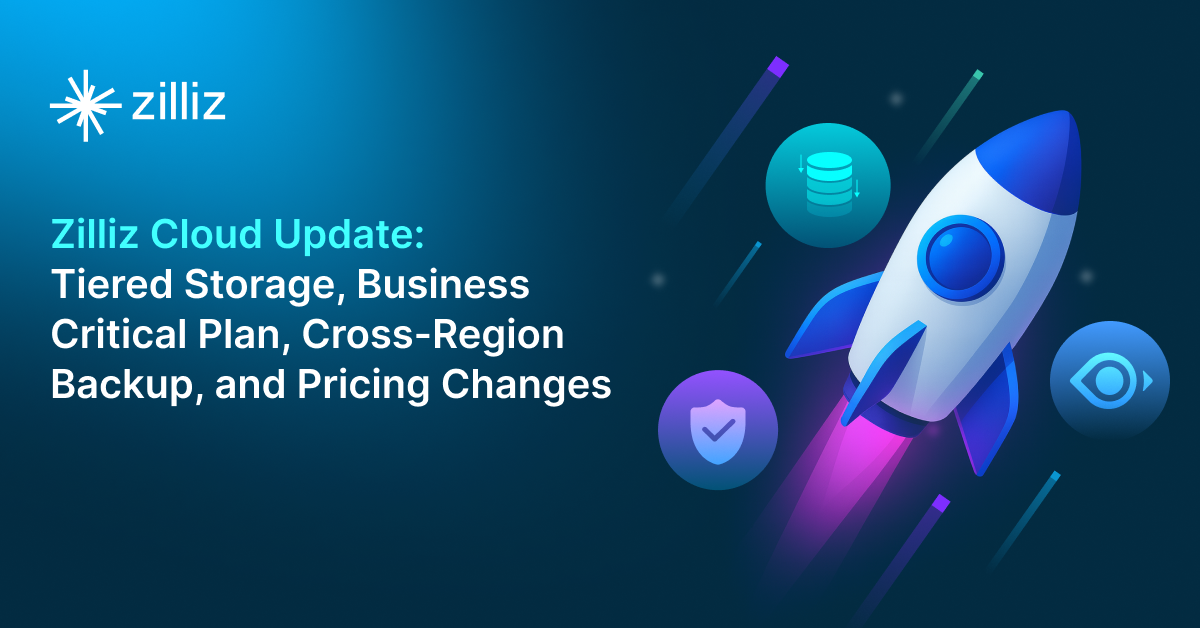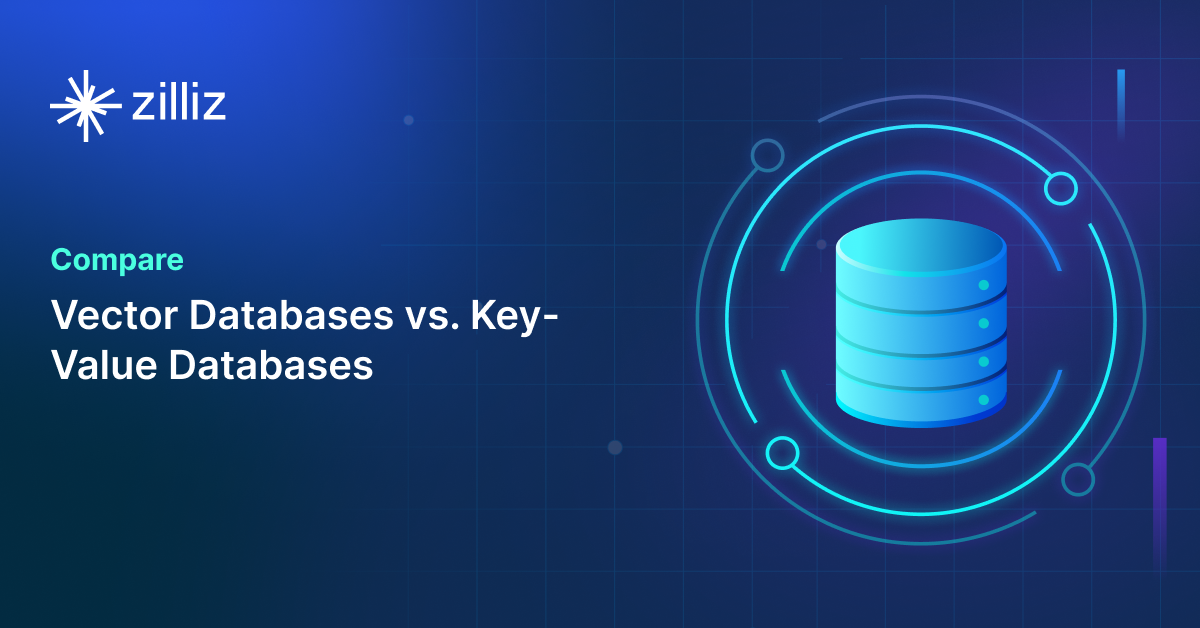Elasticsearch vs Vearch Selecting the Right Database for GenAI Applications

As AI-driven applications evolve, the importance of vector search capabilities in supporting these advancements cannot be overstated. This blog post will discuss two prominent databases with vector search capabilities: Elasticsearch and Vearch. Each provides robust capabilities for handling vector search, an essential feature for applications such as recommendation engines, image retrieval, and semantic search. Our goal is to provide developers and engineers with a clear comparison, aiding in the decision of which database best aligns with their specific requirements.
What is a Vector Database?
Before we compare Elasticsearch vs Vearch let's first explore the concept of vector databases.
A vector database is specifically designed to store and query high-dimensional vectors, which are numerical representations of unstructured data. These vectors encode complex information, such as the semantic meaning of text, the visual features of images, or product attributes. By enabling efficient similarity searches, vector databases play a pivotal role in AI applications, allowing for more advanced data analysis and retrieval.
Common use cases for vector databases include e-commerce product recommendations, content discovery platforms, anomaly detection in cybersecurity, medical image analysis, and natural language processing (NLP) tasks. They also play a crucial role in Retrieval Augmented Generation (RAG), a technique that enhances the performance of large language models (LLMs) by providing external knowledge to reduce issues like AI hallucinations.
There are many types of vector databases available in the market, including:
- Purpose-built vector databases such as Milvus, Zilliz Cloud (fully managed Milvus)
- Vector search libraries such as Faiss and Annoy.
- Lightweight vector databases such as Chroma and Milvus Lite.
- Traditional databases with vector search add-ons capable of performing small-scale vector searches.
Elasticsearch is a search engine based on Apache Lucene with vector search as an add-on. Vearch is a purpose-built vector database. This post compares their vector search capabilities.
Elasticsearch: Overview and Core Technology
Elasticsearch is an open source search engine built on top of the Apache Lucene library. It’s known for real time indexing and full text search so it’s a go to search for heavy applications and log analytics. Elasticsearch lets you search and analyse large amounts of data fast and efficiently.
Elasticsearch was built for search and analytics, with features like fuzzy searching, phrase matching and relevance ranking. It’s great for scenarios where complex search queries and real time data retrieval is required. With the rise of AI applications, Elasticsearch has added vector search capabilities so it can do similarity search and semantic search, which is required for AI use cases like image recognition, document retrieval and Generative AI.
Vector Search
Vector search is integrated in Elasticsearch through Apache Lucene. Lucene organises data into immutable segments that are merged periodically, vectors are added to the segments the same way as other data structures. The process involves buffering vectors in memory at index time, then serializing these buffers as part of segments when needed. Segments are merged periodically for optimization, and searches combine vector hits across all segments.
For vector indexing, Elasticsearch uses the HNSW (Hierarchical Navigable Small World) algorithm which creates a graph where similar vectors are connected to each other. This is chosen for its simplicity, strong benchmark performance and ability to handle incremental updates without requiring complete retraining of the index. The system performs vector searches typically in tens or hundreds of milliseconds, much faster than brute force approaches.
Elasticsearch’s technical architecture is one of its biggest strengths. The system supports lock free searching even during concurrent indexing and maintains strict consistency across different fields when updating documents. So if you update both vector and keyword fields, searches will see either all old values or all new values, data consistency is guaranteed. While the system can scale beyond available RAM, performance optimizes when vector data fits in memory.
Beyond the core vector search capabilities, Elasticsearch provides practical integration features that makes it super valuable. Vector searches can be combined with traditional Elasticsearch filters, so you can do hybrid search that mixes vector similarity with full text search results. The vector search is fully compatible with Elasticsearch’s security features, aggregations and index sorting, so it’s a complete solution for modern search use cases.
What is Vearch? Overview and Core Technology
Vearch is a tool for developers building AI applications that need fast and efficient similarity searches. It’s like a supercharged database, but instead of storing regular data, it’s built to handle those tricky vector embeddings that power a lot of modern AI tech.
One of the coolest things about Vearch is its hybrid search. You can search by vectors (think finding similar images or text) and also filter by regular data like numbers or text. So you can do complex searches like “find products like this one, but only in the electronics category and under $500”. It’s fast too - we’re talking searching on a corpus of millions of vectors in milliseconds.
Vearch is designed to grow with your needs. It uses a cluster setup, like a team of computers working together. You have different types of nodes (master, router and partition server) that handle different jobs, from managing metadata to storing and computing data. This allows Vearch to scale out and be reliable as your data grows. You can add more machines to handle more data or traffic without breaking a sweat.
For developers, Vearch has some nice features that make life easier. You can add data to your index in real-time so your search results are always up-to-date. It supports multiple vector fields in a single document which is handy for complex data. There’s also a Python SDK for quick development and testing. Vearch is flexible with indexing methods (IVFPQ and HNSW) and supports both CPU and GPU versions so you can optimise for your specific hardware and use case. Whether you’re building a recommendation system, similar image search or any AI app that needs fast similarity matching, Vearch gives you the tools to make it happen efficiently.
Key Differences
Elasticsearch vs Vearch for Vector Search: A Developer’s Guide
When choosing between Elasticsearch and Vearch as a vector search tool, you need to compare them across multiple dimensions. Both have vector search capabilities but serve different needs and excel in different scenarios. Here’s a quick rundown to help you pick the right tool for your use case.
Search Methodology
Elasticsearch: Elasticsearch uses vector search with HNSW (Hierarchical Navigable Small World) algorithm through Apache Lucene. HNSW builds a graph where similar vectors are connected, so you can search efficiently. It supports hybrid queries, mixing vector-based searches with traditional keyword-based filters, so it’s good for applications that need complex query combinations.
Vearch:Vearch also supports HNSW and IVFPQ (Inverted File with Product Quantization). HNSW is good for speed and precision, IVFPQ is good for memory efficiency, especially when using GPUs. Vearch is built for AI applications and focuses heavily on similarity matching across vector embeddings.
Data Handling
Elasticsearch: Elasticsearch is designed for structured and semi-structured data. It can handle unstructured data (like text and embeddings) but is rooted in full-text search. It combines search and analytics with vector search so it’s good for hybrid use cases.
Vearch: Vearch is designed for unstructured data, specifically vector embeddings. It supports multiple vector fields in a single document which is useful for AI applications where entities have multiple embeddings (e.g. text and image embeddings). It also handles real-time updates well, so search results are up-to-date.
Scalability and Performance
Elasticsearch: Elasticsearch scales horizontally across clusters and performs well when vector data fits in memory. It handles large datasets by segmenting data and merging them periodically but performance degrades if queries exceed available RAM.
Vearch: Vearch’s architecture is designed for scalability. It uses a cluster-based design with dedicated node roles—master, router, and partition servers. This allows Vearch to scale smoothly as data or traffic grows and specific nodes can handle compute-heavy vector operations. GPU support is also available for demanding AI workloads.
Flexibility and Customization
Elasticsearch: Elasticsearch is good at combining vector search with its mature full-text search capabilities. You can filter and sort results using traditional fields while performing vector similarity matching. It also supports aggregations and hybrid searches so it’s good for various data models.
Vearch: Vearch is highly customizable for AI-driven use cases like recommendation systems and multimedia searches. It has real-time indexing and supports both CPU and GPU computation so you can tune performance based on your hardware. It also supports multiple vector indexing methods, so you have another layer of flexibility.
Integration and Ecosystem
Elasticsearch: As a mature tool, Elasticsearch integrates well with many ecosystems and frameworks, including Kibana for visualization and Logstash for data ingestion. It’s compatible with your existing workflows so it’s a safer choice if you’re already using its ecosystem.
Vearch: Vearch is less mature but more specialized. Its Python SDK makes it easy to integrate into AI pipelines, especially for machine learning and deep learning applications. It doesn’t have the broader ecosystem of Elasticsearch but it’s focused on AI applications so it’s good for embedding-heavy systems.
Ease of Use
Elasticsearch: Elasticsearch is easy to use if you’re already familiar with its ecosystem. But its vector search capabilities are relatively new, so you may need to configure them and have some expertise. Its documentation and community support is a big plus.
Vearch: Vearch is simpler for AI use cases out of the box. Its Python SDK and real-time indexing makes it easier for developers to work with embeddings. But its ecosystem is narrower and less community support may be a challenge for some.
Cost Considerations
Elasticsearch: Cost depends on your cluster size and data volume. Managed Elasticsearch services can add convenience but add cost. It may also require more memory for optimal vector search performance and that will add to the cost.
Vearch: Vearch is designed for large scale AI applications. Its GPU support can add to the hardware cost but provides significant performance gain. Depending on your use case, this can be better value for AI-centric applications.
Security Features
Elasticsearch: Elasticsearch has robust security features including encryption, authentication and access control. All are integrated into its core and managed services so it’s compliant with enterprise security standards.
Vearch: Vearch has fewer security features out of the box but supports basic authentication and access control. For applications that require advanced security you’ll need to implement additional layers manually.
When to Choose Elasticsearch
Elasticsearch is for use cases that combine vector search with traditional search and analytics on big data. It’s great for hybrid search scenarios where you need to mix full-text search, keyword filtering and vector similarity queries. If you’re already using Elasticsearch for log analytics, e-commerce search or enterprise search and want to leverage its robust ecosystem, scalability and integrations then it’s a good choice. If you need complex queries, relevance ranking or compatibility with Kibana and Logstash then Elasticsearch is a safe bet.
When to Choose Vearch
Vearch is for AI-driven applications that heavily rely on vector embeddings such as recommendation engines, image similarity search and generative AI use cases. It’s designed for unstructured vector data and is great for real-time indexing and GPU-accelerated performance. Vearch can handle multiple vector fields per document and supports various indexing methods so it’s perfect for complex data models in AI. If you’re focused on multimedia search or embedding-centric applications with scalability needs then Vearch is the solution for you.
Summary
Elasticsearch and Vearch are both good for vector search but for different reasons. Elasticsearch is versatile, has an ecosystem and hybrid search capabilities so it’s a safe bet for traditional and emerging search workloads. Vearch is optimised for AI applications and does fast and efficient similarity search for embedding heavy use cases. Choose between these two based on your use case, data type and performance requirements so the technology fits your project goals.
Read this to get an overview of Elasticsearch and Vearch but to evaluate these you need to evaluate based on your use case. One tool that can help with that is VectorDBBench, an open-source benchmarking tool for vector database comparison. In the end, thorough benchmarking with your own datasets and query patterns will be key to making a decision between these two powerful but different approaches to vector search in distributed database systems.
Using Open-source VectorDBBench to Evaluate and Compare Vector Databases on Your Own
VectorDBBench is an open-source benchmarking tool for users who need high-performance data storage and retrieval systems, especially vector databases. This tool allows users to test and compare different vector database systems like Milvus and Zilliz Cloud (the managed Milvus) using their own datasets and find the one that fits their use cases. With VectorDBBench, users can make decisions based on actual vector database performance rather than marketing claims or hearsay.
VectorDBBench is written in Python and licensed under the MIT open-source license, meaning anyone can freely use, modify, and distribute it. The tool is actively maintained by a community of developers committed to improving its features and performance.
Download VectorDBBench from its GitHub repository to reproduce our benchmark results or obtain performance results on your own datasets.
Take a quick look at the performance of mainstream vector databases on the VectorDBBench Leaderboard.
Read the following blogs to learn more about vector database evaluation.
Further Resources about VectorDB, GenAI, and ML
- What is a Vector Database?
- Elasticsearch: Overview and Core Technology
- What is Vearch**? Overview and Core Technology**
- Key Differences
- Using Open-source VectorDBBench to Evaluate and Compare Vector Databases on Your Own
- Further Resources about VectorDB, GenAI, and ML
Content
Start Free, Scale Easily
Try the fully-managed vector database built for your GenAI applications.
Try Zilliz Cloud for FreeKeep Reading

Zilliz Cloud Update: Tiered Storage, Business Critical Plan, Cross-Region Backup, and Pricing Changes
This release offers a rebuilt tiered storage with lower costs, a new Business Critical plan for enhanced security, and pricing updates, among other features.

Vector Databases vs. Key-Value Databases
Use a vector database for AI-powered similarity search; use a key-value database for high-throughput, low-latency simple data lookups.

How AI Is Transforming Information Retrieval and What’s Next for You
This blog will summarize the monumental changes AI brought to Information Retrieval (IR) in 2024.
The Definitive Guide to Choosing a Vector Database
Overwhelmed by all the options? Learn key features to look for & how to evaluate with your own data. Choose with confidence.